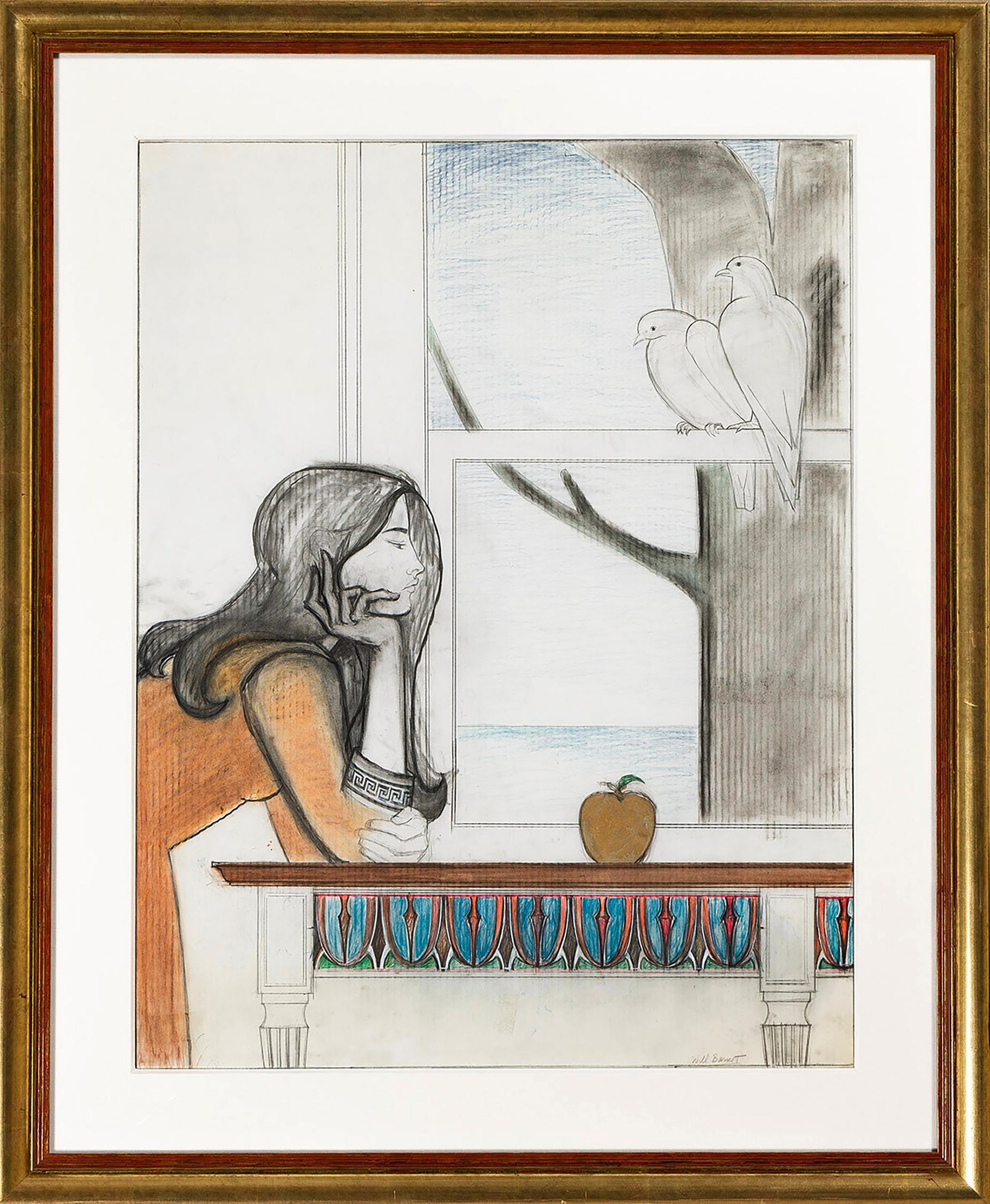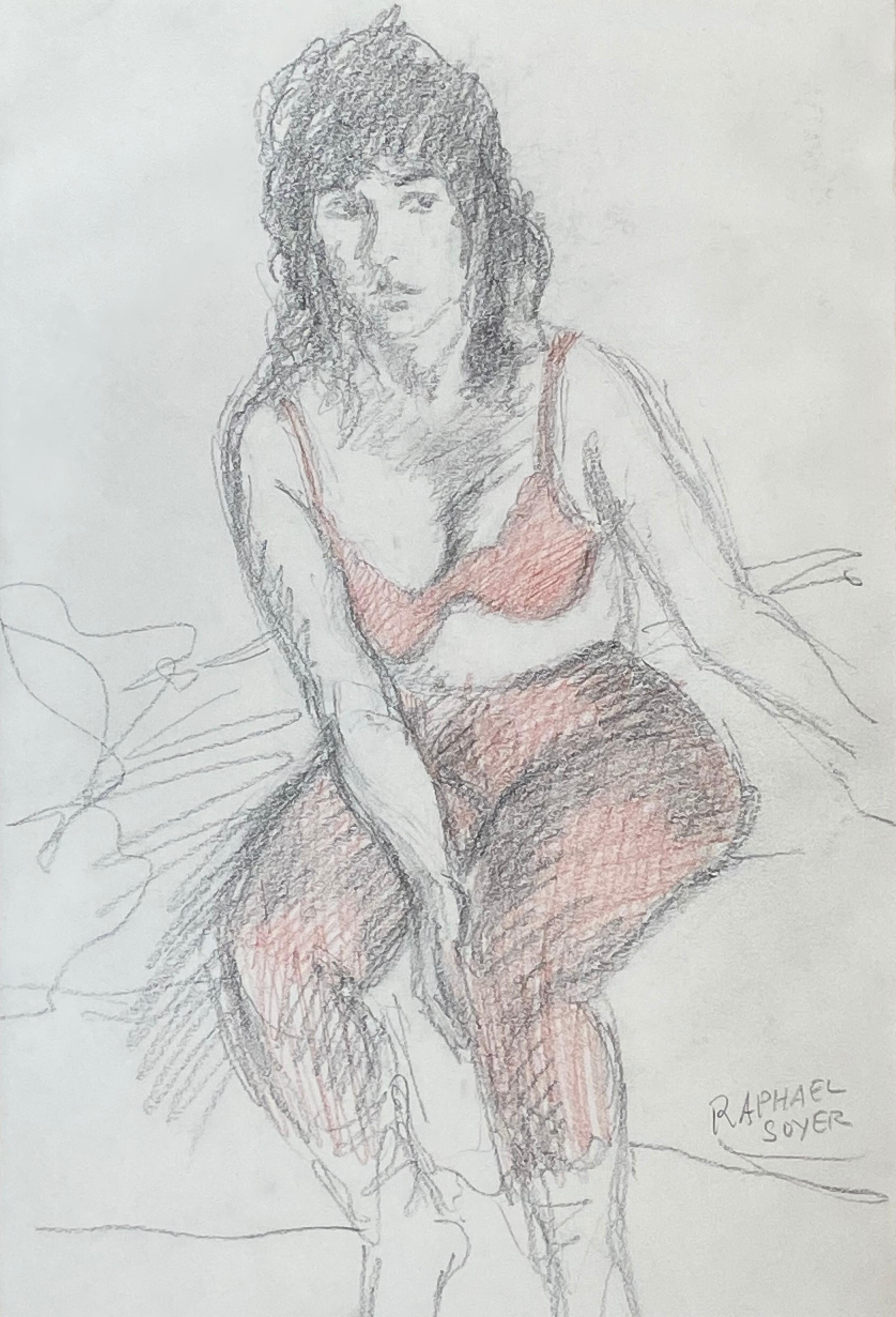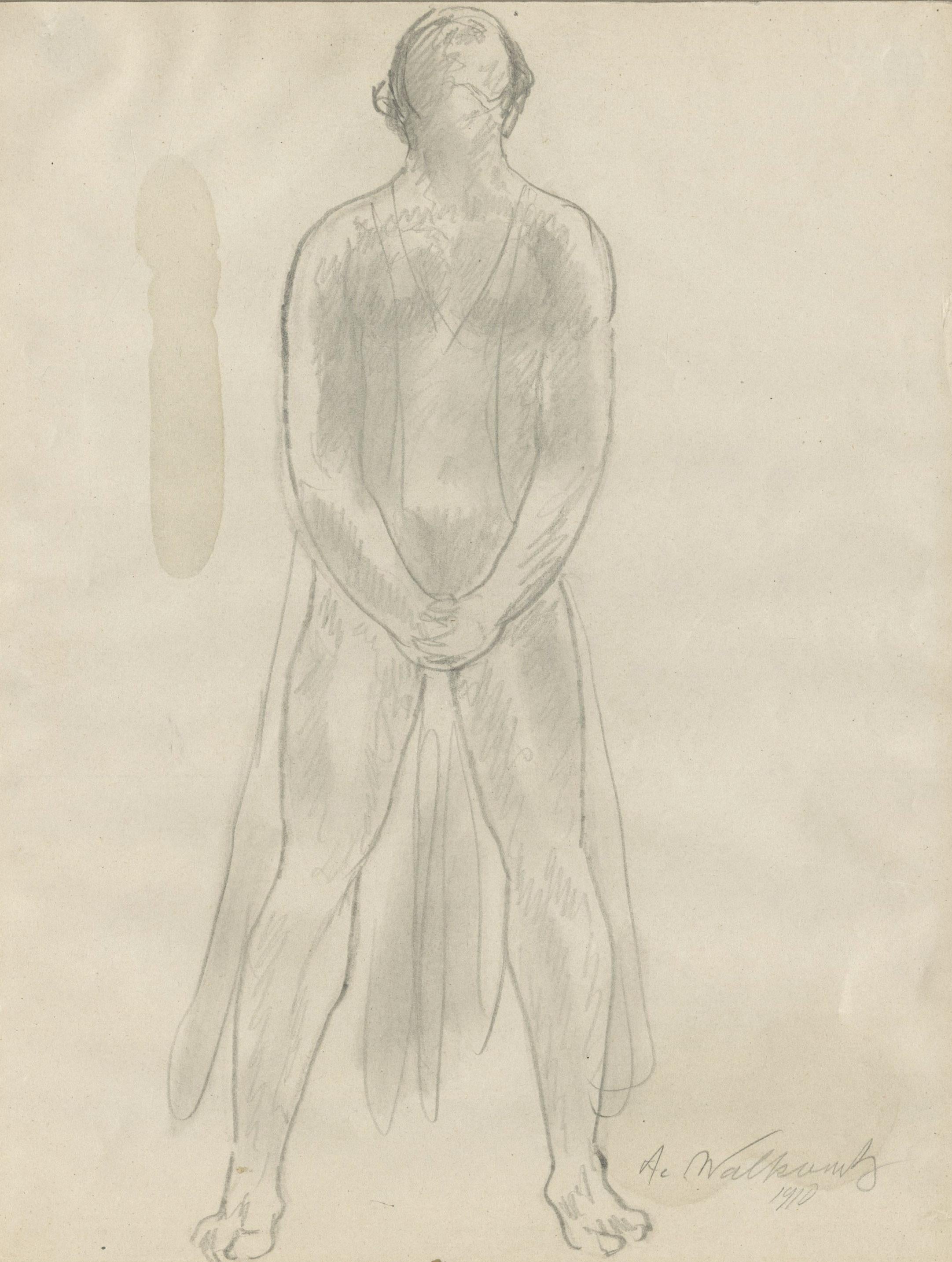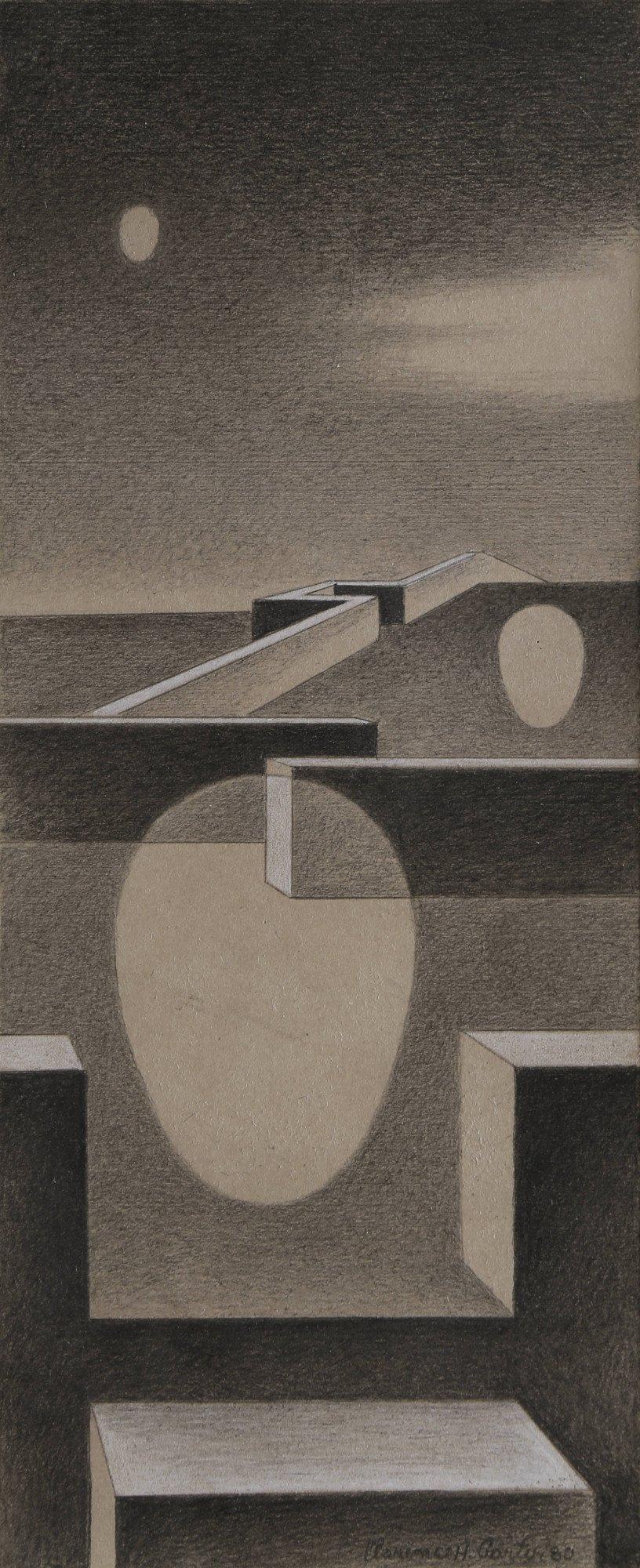Items Similar to Pablo Casals
Want more images or videos?
Request additional images or videos from the seller
1 of 7
August F. BiehlePablo Casals1963
1963
About the Item
Pablo Casals
Graphite on paper, 1963
Signed in pencil lower right (see photo)
Sheet size: 11 5/8 x 8 inches
Condition: glue residue in all four corners of the sheet
Drawn from life during an appearance at Carnegie Hall with the Cleveland Orchestra Chorus where he conducted J.S. Bach: The Passion of Our Lord According to St. Matthew (see photo of handbill)
Regarding Casals: Pau Casals i Defilló
(December 29, 1876 – October 22, 1973)
"The great Spanish cellist (and conductor), Pablo Casals (actually, Pau Carlos Salvador Defilló), legend has it, supported by Casals himself, that he was conceived when Johannes Brahms began his B-flat Major Quartet, of which Casals owned the original manuscript, and that he was born when J. Brahms completed its composition. This legend is rendered moot by the fact that the quartet in question was completed and performed before Casals was even born. But even the ascertainable facts of the life of Casals make it a glorious tale. His father, the parish organist and choirmaster in Vendrell, gave Casals instruction in piano, violin, and organ. When Casals was 11, he first heard the cello performed by a group of traveling musicians, and decided to study the instrument. In 1888 his mother took him to Barcelona, where he enrolled in the Escuela Municipal de Música. There he studied cello with José García, theory with José Rodoreda, and piano with Joaquín Malats and Francisco Costa Llobera. His progress as a cellist was nothing short of prodigious, and he was able to give a solo recital in Barcelona at the age of 14, on February 23, 1891; he graduated with honors in 1893. Albéniz, who heard him play in a cafe trio, gave Pablo Casals a 1etter of introduction to Count Morphy, the private secretary to María Cristina, the Queen Regent, in Madrid. Casals was asked to play at informal concerts in the palace, and was granted a royal stipend for composition study with Tomás Bretón. In 1893 he entered the Conservatory de Musica y Declamacion in Madrid, where he attended chamber music classes of Jesus de Monasterio. He also played in the newly organized Quartet Society there (1894-1895). In 1895 he went to Paris and, deprived of his stipend from Spain, earned a living by playing 2nd cello in the theater orchestra of the Folies Marigny. He decided to return to Spain, where he received, in 1896, an appointment to the faculty of the Escuela Municipal de Música in Barcelona; he was also principal cellist in the orchestra of the Gran Teatro del Liceo. In 1897 he appeared as soloist with the Madrid Symphony Orchestra, and was awarded the Order of Carlos III from the Queen. His career as a cello virtuoso was then assured. In 1899 Pablo Casals played at. the Crystal Palace in London, and later for Queen Victoria at her summer residence at Cowes, Isle of Wight. On November 12, 1899, he appeared as a soloist at a prestigious Lamoureux Concert in Paris, and played with Lamoureux again on December 17, 1899, obtaining exceptional success With both the public and the press. He toured Spain and Holland with the pianist Harold Bauer (1900-1901); then made his first tour of the USA (1901-1902). In 1903 he made a grand tour of South America. On January 15, 1904, he was invited to play at the White House for President Theodore Roosevelt. In 1906 he became associated with the talented young Portuguese cellist Guilhermina Suggia, who studied with him and began to appear in concerts as Mme. P. Casals-Suggia, although they were not legally married. Their liaison was dissolved in 1912; in 1914 Casals married the American socialite and singer Susan Metcalfe; they were separated in 1928, but did not divorce until 1957. Continuing his brilliant career, Pablo Casals organized, in Paris, a concert trio with the piariist Alfred Cortot and the violinist Thibaud; they played concerts together until 1937. Casals also became interested in conducting, and in 1919 he organized, in Barcelona, the Orquesta Pall Casals and led itsftrst concert on October 13, 1920. With the outbreak of the Spanish Civil War in 1936, the Orquesta Pau Casals ceased its activities. Casals was an ardent supporter of the Spanish Republican government, and after its defeat vowed never to return to Spain until democracy was restored. He settled in the French village of Prades, on the Spanish frontier; between 1939 and 1942 he made sporadic appearances as a cellist in the unoccupied zone of southern France and in Switzerland. So fierce was his opposition to the Franco regime in Spain that he declined to appear in countries that recognized the totalitarian Spanish government, making an exception when he took part ill a concert of chamber music in the White House on November 13, 1961, at the invitation of President John F. Kennedy, whom he admired. In 1950 Pablo Casals resumed his career as conductor and cellist at the Prades Festival, organized in commemoration of the bicentennial of the death of J.S. Bach; he continued leading the Prades Festivals until 1966. He made his permanent residence in 1956, when he settled in San Juan, Puerto Rico (his mother was born there when the island was still under Spanish rule). In 1957 an annual Festival Casals was inaugurated there. During all these years, he developed energetic activities as a pedagogue, leading master classes in Switzerland, Italy, Berkeley, California, and Marlboro, Vermount, some of which were televised. Pablo Casals was also a composer; perhaps his most effective work is La sardana, for an ensemble of cellos, which he composed in 1926. His oratorio El pessebre (The Manger) was performed for the first time in Acapulco, Mexico, on December 17, 1960. One of his last compositions was the Himno a las Naciones Unidas (Hymn of the United Nations); he conducted its ftrst performance in a special concert at the United Nations on October 24, 1971, 2 months before his 95th birthday. On August 3, 1957, at the age of 80, Casals married his young pupil Marta Montañez; following his death, she married the pianist Eugene Istomin, on February 15, 1975. Casals did not live to see the liberation of Spain from the Franco dictatorship, but he was posthumously honored by the Spanish government under King Juan Carlos I, which issued in 1976 a commemorative postage stamp in honor of his 100th birthday." Courtesy of Rare Classical Music
Regarding August F. Biehle
"The son of a German immigrant painter of decorative murals in Cleveland, Ohio, he achieved distinction as one of Ohio's most prolific and talented artists, especially noted for design and draftsmanship. His styles embraced Expressionism, Fauvism, Cubism, and American Scene Realism, and he worked in a variety of media including graphite, oil, gouache, pastel, tempera, and lithography.
He started drawing as a youngster and served as an apprentice to his father working on decorative commissions in Cleveland, Chicago, and surrounding areas. In 1903, when he was eighteen, he went to Munich to study at the Kunstgewerbeschule, a respected arts and crafts school. In 1908, he began working as a color consultant to Sherwin Williams Paint Company, and two years later returned to Munich where he studied at the Royal Academy and came under the influence of various modernist movements. He became an important link between these styles and Ohio painters, joining the artists' colony led by Henry Keller near Sandusky.
In the 1920s and 30s, he did numerous American Scene paintings and painted WPA murals during the Depression. From 1913 to 1952, he earned his living as a lithographer but during this time painted independently. In the 1960s, he turned to complete abstraction.
He died in 1979, having had a career of nearly seventy years. His paintings have been in numerous exhibitions including the Cleveland Museum of Art, the Butler Museum in Youngstown, the Pennsylvania Academy of Fine Arts in Philadelphia and the Whitney Museum in New York City."
Courtesy: AskArt
- Creator:August F. Biehle (1885 - 1979, American)
- Creation Year:1963
- Dimensions:Height: 11.625 in (29.53 cm)Width: 8 in (20.32 cm)
- Medium:
- Movement & Style:
- Period:
- Condition:
- Gallery Location:Fairlawn, OH
- Reference Number:
About the Seller
5.0
Recognized Seller
These prestigious sellers are industry leaders and represent the highest echelon for item quality and design.
Platinum Seller
These expertly vetted sellers are 1stDibs' most experienced sellers and are rated highest by our customers.
Established in 1978
1stDibs seller since 2013
711 sales on 1stDibs
Typical response time: 1 hour
Associations
International Fine Print Dealers Association
- ShippingRetrieving quote...Ships From: Fairlawn, OH
- Return PolicyA return for this item may be initiated within 10 days of delivery.
More From This SellerView All
- Seated CoupleBy Raphael SoyerLocated in Fairlawn, OHInspiration (Seated Couple) Graphite on paper, c. 1967 Signed twice in pencil by the artist on recto (see photos) Condition: Excellent Image size: 13 x 16 inches Note: Although not t...Category
1960s American Modern Figurative Drawings and Watercolors
MaterialsGraphite
- Reclining Female NudeBy Emil GansoLocated in Fairlawn, OHReclining Female Nude Charcoal on paper, c. 1933 Signed lower right (see photo) Provenance: Weyhe Gallery, New York (Ganso's dealer 1925-1941) Joseph Mark Erdelac, Cleveland, noted collector who had a large collection of Ganso works Ganso was born in Germany in 1895. At age 14, he apprenticed to a baker and then worked his way to America when he was 17. He worked in bakeries in Scranton, Pennsylvania; and Cincinnati and Akron, Ohio. By 1916, Ganso out of a job, and was living the life of a bohemian in New York City, sometimes on less than 30 cents a week.1 In 1921, Ganso painted a realistic nude on a bedsheet, and was forced by the police to remove it from an exhibition. The bedsheet with the painting was later stolen. He soon had a job baking again at $140 a month, and with time to spare for painting and study. Ganso quit baking in 1925 when a New York dealer gave him financial backing of $50 a week. Ganso prospered from his art after that. His work is in over 15 American museums, and the Print Club of Cleveland awarded him a $500 purchase prize for a wood engraving. A versatile artist, he painted a variety of subjects. (from a profile written by Clyde Singer...Category
1930s American Modern Nude Drawings and Watercolors
MaterialsGraphite
- Isadora DuncanBy Abraham WalkowitzLocated in Fairlawn, OHIsadora Duncan Graphite with grey wash on paper mounted to cardstock Signed and dated in pencil lower right (see photo) Provenance: Charlotte Bergman, f...Category
1910s American Modern Figurative Drawings and Watercolors
MaterialsGraphite
- Untitled (Study for The Aerialists)By John Steuart CurryLocated in Fairlawn, OHUntitled (Study for The Aerialists) Graphite on paper, 1932 Signed lower right in pencil: "John Steuart Curry" Dated: 1932 in pencil Exhibited: Schroeder Romero & Shredder, NYC (la...Category
1930s American Modern Figurative Drawings and Watercolors
MaterialsGraphite
- Volunteer Firemen, ProvincetownBy E. Ambrose WebsterLocated in Fairlawn, OHPreparatory drawing for Volunteer Firemen, Provincetown Graphite on paper, 1932 Initialed in pencil by the artist lower left: W Provenance: Estate of the artist, 1935 Georgianna Webs...Category
1930s Modern Figurative Drawings and Watercolors
MaterialsGraphite
- Preliminary Study for a Sculpture ProjectBy Boris Lovet-LorskiLocated in Fairlawn, OHPreliminary Study for a Sculpture Project Graphite, charcoal and wash on tracing paper, c. 1930-1940 Signed upper left and lower left (see both photos) Created while the artist was l...Category
1930s American Modern Figurative Drawings and Watercolors
MaterialsCharcoal
You May Also Like
- Final Study for Atalanta, Girl with AppleBy Will BarnetLocated in Greenwich, CTWill Barnet is one of America's best loved and known artists of the Post War era. He is highly distinctive for his figurative and narrative work and in some ways he is the Edgar All...Category
1970s American Modern Figurative Drawings and Watercolors
MaterialsWatercolor, Graphite, Color Pencil, Vellum
- “Seated Model in Red Bra”By Raphael SoyerLocated in Southampton, NYOriginal graphite and colored pencil drawing on archival paper of a woman seated in a red bra by the well known American artist, Raphael Soyer. Signed lower r...Category
1950s American Modern Figurative Drawings and Watercolors
MaterialsGraphite, Archival Paper, Color Pencil
- Study for Worlds Beyond - Surrealist graphite drawing, Ohio artistBy Clarence Holbrook CarterLocated in Beachwood, OHClarence Holbrook Carter (American, 1904-2000) Study for Worlds Beyond, 1980 Graphite, collage and white heightening on illustration board Signed and dated lower right 10.75 x 4.5 in...Category
1980s American Modern Figurative Drawings and Watercolors
MaterialsGraphite
- Women's Corner, Along the Cuyahoga River, Early 20th Century Cleveland SchoolBy Frank WilcoxLocated in Beachwood, OHFrank Nelson Wilcox (American, 1887-1964) Women's Corner, Along the Cuyahoga River, c. 1916 Watercolor and graphite on paper 21 x 29 inches Frank Nelson Wilcox (October 3, 1887 – April 17, 1964) was a modernist American artist and a master of watercolor. Wilcox is described as the "Dean of Cleveland School painters," though some sources give this appellation to Henry Keller or Frederick Gottwald. Wilcox was born on October 3, 1887 to Frank Nelson Wilcox, Sr. and Jessie Fremont Snow Wilcox at 61 Linwood Street in Cleveland, Ohio. His father, a prominent lawyer, died at home in 1904 shortly before Wilcox' 17th birthday. His brother, lawyer and publisher Owen N. Wilcox, was president of the Gates Legal Publishing Company or The Gates Press. His sister Ruth Wilcox was a respected librarian. In 1906 Wilcox enrolled from the Cleveland School of Art under the tutelage of Henry Keller, Louis Rorimer, and Frederick Gottwald. He also attended Keller's Berlin Heights summer school from 1909. After graduating in 1910, Wilcox traveled and studied in Europe, sometimes dropping by Académie Colarossi in the evening to sketch the model or the other students at their easels, where he was influenced by French impressionism. Wilcox was influenced by Keller's innovative watercolor techniques, and from 1910 to 1916 they experimented together with impressionism and post-impressionism. Wilcox soon developed his own signature style in the American Scene or Regionalist tradition of the early 20th century. He joined the Cleveland School of Art faculty in 1913. Among his students were Lawrence Edwin Blazey, Carl Gaertner, Paul Travis, and Charles E. Burchfield. Around this time Wilcox became associated with Cowan Pottery. In 1916 Wilcox married fellow artist Florence Bard, and they spent most of their honeymoon painting in Berlin Heights with Keller. They had one daughter, Mary. In 1918 he joined the Cleveland Society of Artists, a conservative counter to the Bohemian Kokoon Arts Club, and would later serve as its president. He also began teaching night school at the John Huntington Polytechnic Institute at this time, and taught briefly at Baldwin-Wallace College. Wilcox wrote and illustrated Ohio Indian Trails in 1933, which was favorably reviewed by the New York Times in 1934. This book was edited and reprinted in 1970 by William A. McGill. McGill also edited and reprinted Wilcox' Canals of the Old Northwest in 1969. Wilcox also wrote, illustrated, and published Weather Wisdom in 1949, a limited edition (50 copies) of twenty-four serigraphs (silk screen prints) accompanied by commentary "based upon familiar weather observations commonly made by people living in the country." Wilcox displayed over 250 works at Cleveland's annual May Show. He received numerous awards, including the Penton Medal for as The Omnibus, Paris (1920), Fish Tug on Lake Erie (1921), Blacksmith Shop (1922), and The Gravel Pit (1922). Other paintings include The Trailing Fog (1929), Under the Big Top (1930), and Ohio Landscape...Category
1910s American Modern Figurative Drawings and Watercolors
MaterialsGraphite, Watercolor
- Cows by Woodland Pond, Toledo, Ohio, Early 20th Century Cleveland SchoolBy Frank WilcoxLocated in Beachwood, OHFrank Nelson Wilcox (American, 1887-1964) Cows by Woodland Pond, Toledo, Ohio, c. 1920 Watercolor and graphite on board Signed lower right 22 x 30 inches Frank Nelson Wilcox (October 3, 1887 – April 17, 1964) was a modernist American artist and a master of watercolor. Wilcox is described as the "Dean of Cleveland School painters," though some sources give this appellation to Henry Keller or Frederick Gottwald. Wilcox was born on October 3, 1887 to Frank Nelson Wilcox, Sr. and Jessie Fremont Snow Wilcox at 61 Linwood Street in Cleveland, Ohio. His father, a prominent lawyer, died at home in 1904 shortly before Wilcox' 17th birthday. His brother, lawyer and publisher Owen N. Wilcox, was president of the Gates Legal Publishing Company or The Gates Press. His sister Ruth Wilcox was a respected librarian. In 1906 Wilcox enrolled from the Cleveland School of Art under the tutelage of Henry Keller, Louis Rorimer, and Frederick Gottwald. He also attended Keller's Berlin Heights summer school from 1909. After graduating in 1910, Wilcox traveled and studied in Europe, sometimes dropping by Académie Colarossi in the evening to sketch the model or the other students at their easels, where he was influenced by French impressionism. Wilcox was influenced by Keller's innovative watercolor techniques, and from 1910 to 1916 they experimented together with impressionism and post-impressionism. Wilcox soon developed his own signature style in the American Scene or Regionalist tradition of the early 20th century. He joined the Cleveland School of Art faculty in 1913. Among his students were Lawrence Edwin Blazey, Carl Gaertner, Paul Travis, and Charles E. Burchfield. Around this time Wilcox became associated with Cowan Pottery. In 1916 Wilcox married fellow artist Florence Bard, and they spent most of their honeymoon painting in Berlin Heights with Keller. They had one daughter, Mary. In 1918 he joined the Cleveland Society of Artists, a conservative counter to the Bohemian Kokoon Arts Club, and would later serve as its president. He also began teaching night school at the John Huntington Polytechnic Institute at this time, and taught briefly at Baldwin-Wallace College. Wilcox wrote and illustrated Ohio Indian Trails in 1933, which was favorably reviewed by the New York Times in 1934. This book was edited and reprinted in 1970 by William A. McGill. McGill also edited and reprinted Wilcox' Canals of the Old Northwest in 1969. Wilcox also wrote, illustrated, and published Weather Wisdom in 1949, a limited edition (50 copies) of twenty-four serigraphs (silk screen prints) accompanied by commentary "based upon familiar weather observations commonly made by people living in the country." Wilcox displayed over 250 works at Cleveland's annual May Show. He received numerous awards, including the Penton Medal for as The Omnibus, Paris (1920), Fish Tug on Lake Erie (1921), Blacksmith Shop (1922), and The Gravel Pit (1922). Other paintings include The Trailing Fog (1929), Under the Big Top (1930), and Ohio Landscape...Category
1920s American Modern Figurative Drawings and Watercolors
MaterialsWatercolor, Graphite
- Crashing Waves on Atlantic Coast, Mid-century Seascape, Cleveland School ArtistBy Frank WilcoxLocated in Beachwood, OHFrank Nelson Wilcox (American, 1887-1964) Crashing Waves on the Atlantic Coast, 1957 Watercolor and graphite on paper Signed and dated lower right 22 x 29 inches Frank Nelson Wilcox (October 3, 1887 – April 17, 1964) was a modernist American artist and a master of watercolor. Wilcox is described as the "Dean of Cleveland School painters," though some sources give this appellation to Henry Keller or Frederick Gottwald. Wilcox was born on October 3, 1887 to Frank Nelson Wilcox, Sr. and Jessie Fremont Snow Wilcox at 61 Linwood Street in Cleveland, Ohio. His father, a prominent lawyer, died at home in 1904 shortly before Wilcox' 17th birthday. His brother, lawyer and publisher Owen N. Wilcox, was president of the Gates Legal Publishing Company or The Gates Press. His sister Ruth Wilcox was a respected librarian. In 1906 Wilcox enrolled from the Cleveland School of Art under the tutelage of Henry Keller, Louis Rorimer, and Frederick Gottwald. He also attended Keller's Berlin Heights summer school from 1909. After graduating in 1910, Wilcox traveled and studied in Europe, sometimes dropping by Académie Colarossi in the evening to sketch the model or the other students at their easels, where he was influenced by French impressionism. Wilcox was influenced by Keller's innovative watercolor techniques, and from 1910 to 1916 they experimented together with impressionism and post-impressionism. Wilcox soon developed his own signature style in the American Scene or Regionalist tradition of the early 20th century. He joined the Cleveland School of Art faculty in 1913. Among his students were Lawrence Edwin Blazey, Carl Gaertner, Paul Travis, and Charles E. Burchfield. Around this time Wilcox became associated with Cowan Pottery. In 1916 Wilcox married fellow artist Florence Bard, and they spent most of their honeymoon painting in Berlin Heights with Keller. They had one daughter, Mary. In 1918 he joined the Cleveland Society of Artists, a conservative counter to the Bohemian Kokoon Arts Club, and would later serve as its president. He also began teaching night school at the John Huntington Polytechnic Institute at this time, and taught briefly at Baldwin-Wallace College. Wilcox wrote and illustrated Ohio Indian Trails in 1933, which was favorably reviewed by the New York Times in 1934. This book was edited and reprinted in 1970 by William A. McGill. McGill also edited and reprinted Wilcox' Canals of the Old Northwest in 1969. Wilcox also wrote, illustrated, and published Weather Wisdom in 1949, a limited edition (50 copies) of twenty-four serigraphs (silk screen prints) accompanied by commentary "based upon familiar weather observations commonly made by people living in the country." Wilcox displayed over 250 works at Cleveland's annual May Show. He received numerous awards, including the Penton Medal for as The Omnibus, Paris (1920), Fish Tug on Lake Erie (1921), Blacksmith Shop (1922), and The Gravel Pit (1922). Other paintings include The Trailing Fog (1929), Under the Big Top (1930), and Ohio Landscape...Category
1950s American Modern Figurative Drawings and Watercolors
MaterialsGraphite, Watercolor





